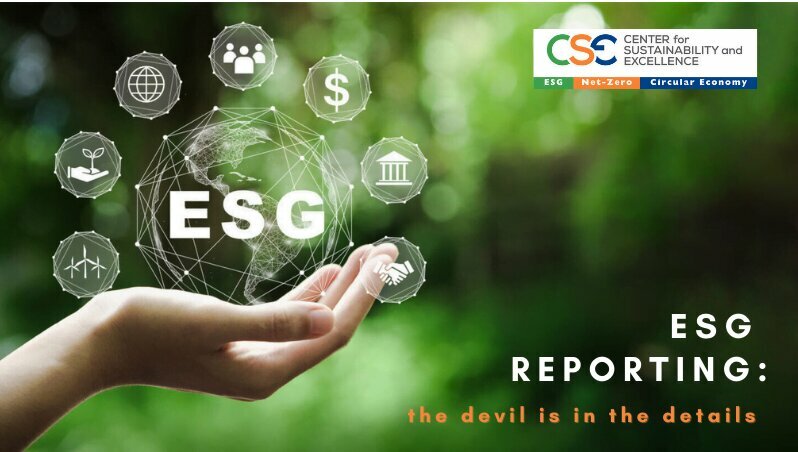
Guest Author: Nikos Avlonas, CSE President, Professor at UIC
FACT 1: The severe impacts of climate change have put a mounting pressure on governments, business, consumers and stakeholders alike, in order to meet regulatory requirements, that will help reduce their environmental footprint and become more sustainable.
FACT 2: During the pandemic we all learned, the hard way, that sustainability is much more than tackling environmental risks; it is about creating resilience into infrastructure.
Governments have announced bold plans to decarbonize the economy and aim for net-zero emissions by 2050. EU member states must have established circular economies, having achieved net-zero emissions by 2050 while ESG Reporting is already mandatory in Europe.
And this is where the Environmental, Social and Governance (ESG)conversation comes into play. On one hand there is a heightened social, corporate, governmental and consumer attention on the impact of corporations. On the other hand, companies (large and small) are under pressure to present concrete ESG reporting data, ever since many countries have implemented regulations, such as carbon taxes and the financial and banking sectors have integrated ESG rules into their funding criteria. So, failing to act on sustainability and / or be able to present a coherent ESG report, may result to severe financial consequences.
ESG criteria: easy to learn, difficult to master
Let’s quickly sum up what the three elements of ESG is all about. Environmental criteria take into consideration how a corporation behaves towards the environment. Social criteria examine how the company maintains connections with its workforce, vendors, customers, and the communities in which it operates; what is its impact on people at each stage of its value or supply chain. Governance is focusing on the leadership of a corporation, executive remuneration, audits, internal controls, and shareholder rights.
With so many variables involved, it is quite complex (to say the least) to calculate and track a company's social and environmental impact, as well as assessing its governance over time. Not only must you – as a company – behave sustainably, but you also need to constantly optimize, improve, and finally present concrete evidence of your actions in writing.
That is why, preparing a detailed ESG Report in a way that adds value to the company is not an easy task. In order to face this challenge, every company needs to have a sustainability team in place continually working with senior management, as well as business units and functional departments, to ensure ESG standards are integrated into the company’s business strategy and daily operations and relevant ESG data are properly disclosed.
Are companies prepared to face the ESG challenge?
According to an online survey, conducted by the independent research agency Coleman Parkes and Workiva, the majority - nearly two-thirds - of decision-makers who participated indicated their companies were "underprepared to meet their environmental, social, and governance (ESG) goals and regulatory reporting mandates." This survey, that spanned across the United States, Europe and Singapore, with a total of 1,300 organizations providing insight, gave more interesting findings:
At the same time, there are many different agencies providing ESG assessment, each with their own metrics, methodology and scoring mechanisms. Companies often choose to integrate the ones most relevant to one’s business and those that are sought after by investors.
Seven (7) months ago, the International Organisation of Securities Commission (IOSCO) proposed for ESG data and ratings to be placed under the remit of securities regulators, in order to improve the reliability and comparability of ESG products and increase trust among users. Although there is a push from users to have comparable and harmonized ESG data and ratings, it is uncertain when this will happen.
Until then, we can extract some valuable lessons from the Top 10 ESG performing companies in 16 different sectors who seem to be getting it right, as they were identified by the 2021 Annual Research into ESG Ratings and Sustainability Reporting Trends of the Center for Sustainability and Excellence (CSE) in N.America.
CSE’s research showcased a pattern for high ESG scores including:
The findings demonstrate a significant increase in the use of ESG standards (e.g GRI, SASB, TCFD) from leading companies.
Among the most interesting findings is that more than 55% of the Top 10 ESG performing companies produce stand-alone Sustainability (ESG) Reports, while 60% of them apply the GRI Standards. Additionally, SASB Standards are used by 56% of the companies under investigation, TCFD recommendations by 30% and the Science-based Targets for GHG emissions reductions by another 30%.
The key success factors above inspired CSE to create an Integrated Sustainability System Methodology, and the ESG Estimate tool to guide and support companies to a successful integration of ESG criteria.
It seems the new way of doing business is essentially a long-lasting sustainability transformation to ensure growth, agility, and good risk management. Leading companies are adopting a more strategic approach towards ESG and making use of specific global standards and frameworks. This allows for better consolidation of scores, easier comparability, and greater transparency for all stakeholders.
CSE is proud to be leading the sustainability and ESG transformation through specialized Certified Training Programs, tailor made Online Courses and Sector-specific, Integrated Consulting Services.
See more: www.cse-net.org